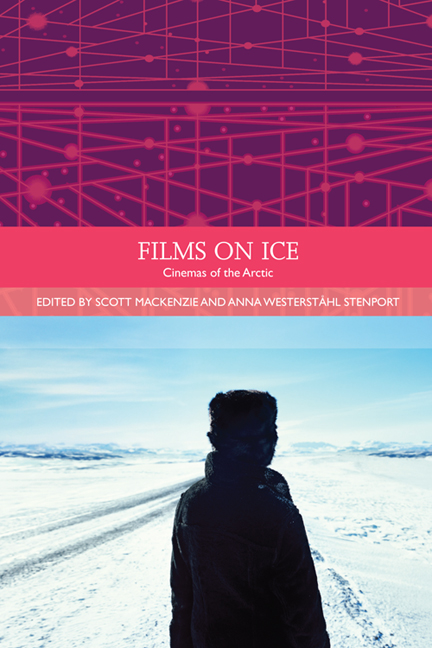Book contents
- Frontmatter
- Contents
- List of Illustrations
- Acknowledgements
- Traditions in World Cinema
- Introduction: What are Arctic Cinemas?
- PART I GLOBAL INDIGENEITY
- PART II HOLLYWOOD HEGEMONY
- 8 Fact and Fiction in ‘Northerns’ and Early ‘Arctic Films’
- 9 California's Yukon as Comic Space
- 10 ‘See the Crashing Masses of White Death…’: Greenland, Germany and the Sublime in the ‘Bergfilm’ SOS Eisberg
- 11 The Threat of the Thaw: The Cold War on the Screen
- 12 Hollywood Does Iceland: Authenticity, Genericity and the Picturesque
- 13 White on White: Twenty-First-Century Norwegian Horror Films Negotiate Masculinist Arctic Imaginaries
- PART III ETHNOGRAPHY AND THE DOCUMENTARY DILEMMA
- PART IV MYTHS AND MODES OF EXPLORATION
- Notes on the Contributors
- Index
8 - Fact and Fiction in ‘Northerns’ and Early ‘Arctic Films’
from PART II - HOLLYWOOD HEGEMONY
Published online by Cambridge University Press: 05 September 2016
- Frontmatter
- Contents
- List of Illustrations
- Acknowledgements
- Traditions in World Cinema
- Introduction: What are Arctic Cinemas?
- PART I GLOBAL INDIGENEITY
- PART II HOLLYWOOD HEGEMONY
- 8 Fact and Fiction in ‘Northerns’ and Early ‘Arctic Films’
- 9 California's Yukon as Comic Space
- 10 ‘See the Crashing Masses of White Death…’: Greenland, Germany and the Sublime in the ‘Bergfilm’ SOS Eisberg
- 11 The Threat of the Thaw: The Cold War on the Screen
- 12 Hollywood Does Iceland: Authenticity, Genericity and the Picturesque
- 13 White on White: Twenty-First-Century Norwegian Horror Films Negotiate Masculinist Arctic Imaginaries
- PART III ETHNOGRAPHY AND THE DOCUMENTARY DILEMMA
- PART IV MYTHS AND MODES OF EXPLORATION
- Notes on the Contributors
- Index
Summary
From the very earliest days of the cinema, the screen depicted a curious blend of the everyday – the Lumieres’ factory workers and breakfasting babies – and the exotic, such as the Edison films of the Sioux Ghost Dance or Professor Welton's boxing cats. As it did throughout the era of what Tom Gunning has aptly dubbed the ‘cinema of attraction’ (Gunning 1986), the camera remained stationary for both kinds of subjects, and yet, as the appetite of audiences for exotic scenes and peoples continued to grow, by stages – at first sated and then whetted for more – the possibility of taking the camera itself to a display of exotic peoples offered one ready way to satisfy them. The exhibitions of various ethnic ‘villages’ at World's Fairs, a staple of such exhibitions since the 1870s, offered one relatively inexpensive means to do so, and in fact we find that both Edison and the American Mutoscope and Biograph Company brought cameras to the 1901 Pan-American Exposition in Buffalo, NY partly for that purpose. Thus, the very earliest footage of Inuit people ever made was taken at that fair's ‘Esquimaux Village’, with three Edison shorts preserved as paper prints at the Library of Congress our first evidence of the Arctic fascination. They were classed as ‘actualities’, of course, but since the icebergs were made of plaster and the dogsleds set on wheels, they might well be considered more fictional than factual.
Therein lies a central problem of early Arctic films: their audiences, schooled by earlier visual entertainments, ‘knew’ only a few things about the ‘Frozen North’: of course they had seen snow, fur-clad Eskimos (Inuit), and igloos but as far as they knew the same region contained totem poles, French-Canadian trappers, old prospectors and any number of saloons. If presented as ‘actualities’ – an early name for films made from footage actually or purportedly shot at the actual place or event – they were willing to take the word of the intertitles as to what was happening, but when presented with narratives, they preferred strong good and bad characters, dramatic plot twists and a melodramatic conclusion.
- Type
- Chapter
- Information
- Films on IceCinemas of the Arctic, pp. 121 - 133Publisher: Edinburgh University PressPrint publication year: 2014



